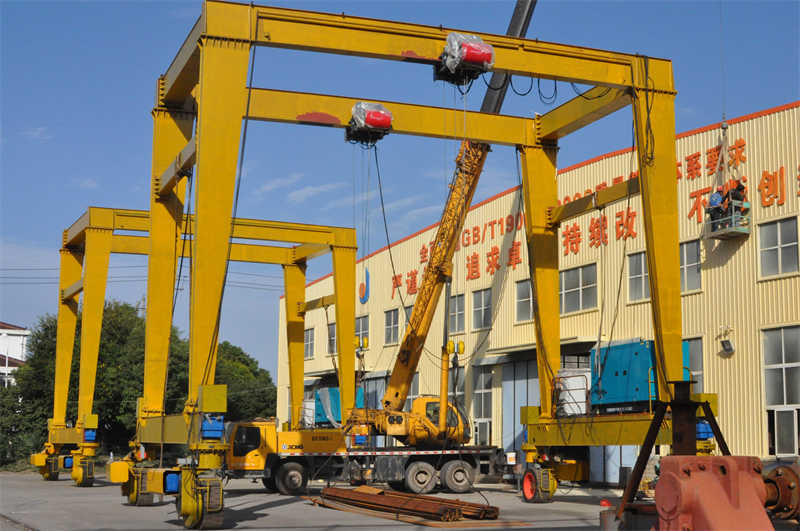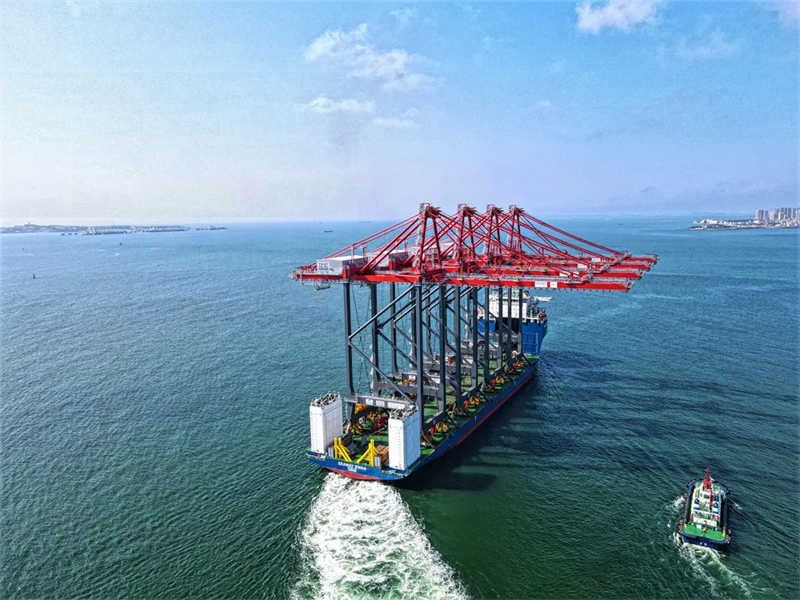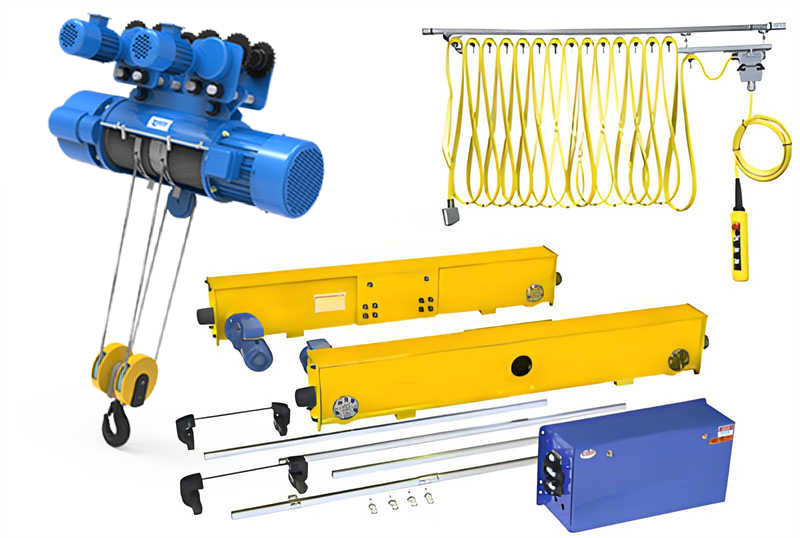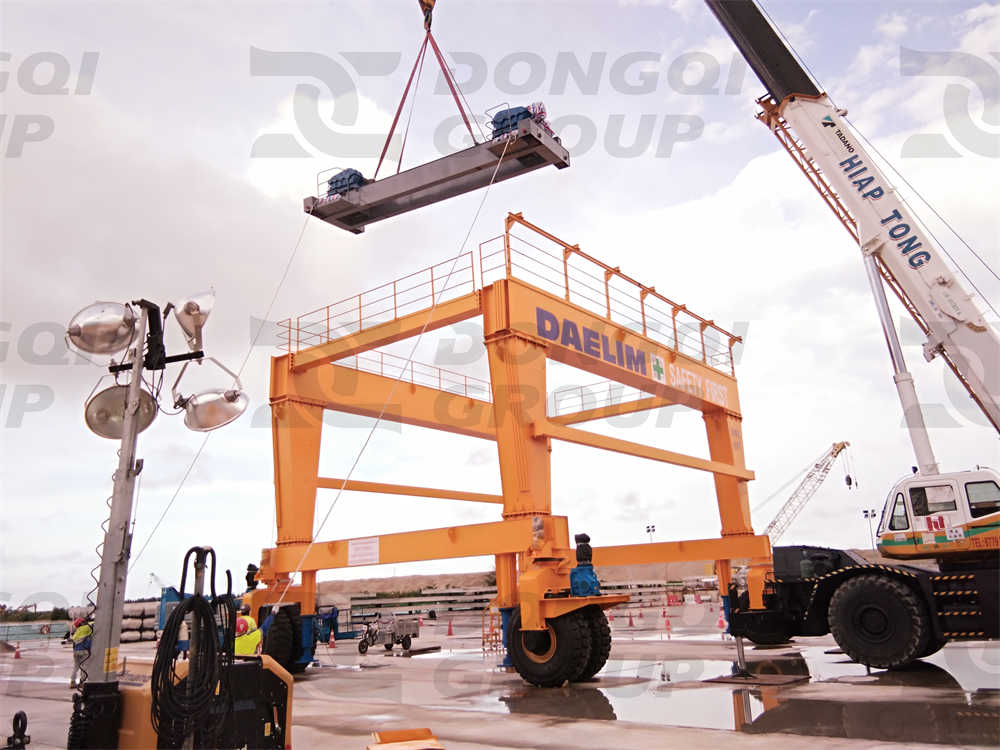21-Jan-2025
Analysis of the impact of rubber tire gantry crane configuration and selection on container terminal efficiency and cost
RTG application issues raised
Background:
With the continuous growth of global trade, the size and cargo capacity of container ships are increasing. In order to adapt to this trend, the construction of container terminals has gradually developed towards large-scale, deep-water and high-efficiency. In this context, the selection of specifications and parameters of RTG (Rubber tired container gantry crane), which is a special loading and unloading equipment for container terminal yards, is particularly important.
Problem:
In recent years, in order to improve the loading and unloading efficiency of ports, various terminals have continuously pursued high-speed in the selection of RTG specifications and parameters, such as lifting speed, trolley speed and other key parameters have been improved. However, this high-speed development has also brought new problems:
- Increase in equipment purchase costs: The improvement of RTG specifications and parameters means that more advanced technology and materials are needed, which will directly lead to an increase in equipment purchase costs.
- Rising operating costs: High-speed RTGs consume more energy during operation and have higher requirements for maintenance, so operating costs will also increase accordingly.
- The effect of promoting terminal loading and unloading efficiency needs to be studied: Although the high-speed development of RTG can improve loading and unloading efficiency in theory, in actual operation, many factors (such as waiting time, equipment failure rate, operator proficiency, etc.) may affect the final operation efficiency. Therefore, the effect of the high-speed development of RTG specifications and parameters on terminal loading and unloading efficiency needs further research and analysis.
Efficiency measurement and analysis of RTG in yard operations
Efficiency measurement software
In order to more scientifically evaluate the efficiency of RTG in yard operations, we have designed a dedicated simulation software. Based on advanced algorithms and models, this software can simulate the operation of RTG in different operating scenarios, so as to accurately calculate its operating efficiency. The core functions of the software include:
- Parameter setting: allows users to enter various technical parameters of RTG, such as lifting speed, trolley speed, yard layout, etc., for customized simulation.
- Operation scenario simulation: According to the parameters entered by the user, the software can simulate the actual operation process of RTG in the yard, including loading and unloading, handling and stacking of containers.
- Efficiency calculation: Based on the simulation results, the software can automatically calculate the operating efficiency of RTG, such as the number of containers completed per hour, average operating time, etc.
RTG efficiency calculation (ideal state – smooth loading and unloading)

Parameter impact analysis
In the operating efficiency of RTG, lifting speed and trolley speed are two crucial technical parameters. In order to gain a deeper understanding of the impact of these two parameters on efficiency, we conducted the following analysis:
- Lifting speed: The lifting speed determines the speed at which the RTG lifts the container from the ground or the yard and puts it in the specified position. In theory, increasing the lifting speed can shorten the loading and unloading time of a single container, thereby improving the overall operating efficiency. However, in actual operations, the increase in lifting speed is restricted by many factors, such as mechanical structure, power system and safety regulations.
- Trolley speed: Trolley speed refers to the speed at which the RTG moves the container on the horizontal plane. Increasing the trolley speed can shorten the moving time of the container in the yard, thereby improving the operating efficiency. But similarly, the increase in trolley speed is also restricted by mechanical structure, track conditions and safety regulations.
Efficiency curve analysis
Using the efficiency calculation software designed by us, we simulated and analyzed the RTG operating efficiency under different lifting speeds and trolley speeds. The results show:
- Limited efficiency improvement: With the increase of lifting speed and trolley speed, the operating efficiency of RTG has indeed improved. But the improvement gradually decreases, showing a trend of “diminishing marginal effect”. This means that when the speed increases to a certain extent, the improvement of efficiency by increasing the speed will become very limited.
- The cost increase is not proportional to the efficiency improvement: With the increase in speed, the purchase cost, operation cost and maintenance cost of RTG will increase accordingly. However, as mentioned above, the improvement in efficiency is limited. Therefore, there is an optimal speed range that maximizes the cost-effectiveness ratio.

Efficiency test of RTG in actual yard operation
Case analysis
In order to more intuitively understand the efficiency performance of RTG in actual yard operation, we selected four representative operation cases for analysis, which cover different operation types such as loading and receiving containers.
Case 1: Loading operation
Operation description: A large container ship needs to load a large amount of cargo, and RTG is responsible for moving the containers on the yard to the ship deck.
Operation time: lasts for 12 hours.
Efficiency performance: During the operation, RTG completes the loading and unloading of 18 containers per hour on average. However, due to the common waiting situation (such as waiting for containers to arrive, waiting for ship deck space, etc.), the actual operation efficiency is lower than the theoretical expectation.
Case 2: Container receiving operation
Operation description: A large number of containers arriving at the port need to be unloaded and stacked on the yard, and RTG is responsible for the handling work in this process.
Operation time: lasts for 8 hours.
Efficiency performance: RTG completes the unloading and stacking of 20 containers per hour on average. However, due to the complex layout of the yard, RTG spent a lot of time looking for a suitable stacking location, resulting in a decrease in actual operation efficiency.
Case 3: Mixed operation (ship loading + container collection)
Operation description: RTG needs to handle both ship loading and container collection operations in the same time period.
Operation time: 10 hours.
Efficiency performance: In the mixed operation mode, the average operation efficiency of RTG is greatly affected, and only 15 containers are loaded and unloaded per hour. This is mainly due to the increase in operation switching and waiting time.
Case 4: Night operation
Operation description: In order to make full use of time resources, the terminal arranges RTG to operate at night.
Operation time: 6 hours.
Efficiency performance: Although the night operation environment is relatively quiet, the average operation efficiency of RTG has not been significantly improved, and 17 containers are loaded and unloaded per hour. This is mainly due to factors such as limited lighting conditions at night and operator fatigue.
Efficiency comparison
By comparing the actual operation efficiency with the theoretical operation efficiency, we found that the actual operation efficiency is generally lower than the theoretical expectation. This is mainly due to the widespread existence of waiting time, including waiting for containers to arrive, waiting for ship deck space, finding a suitable stacking location, and operation switching. These factors have led to the waste of time of RTG during the operation process, thereby reducing the actual operation efficiency.
Analysis of the impact of RTG on the operating efficiency of container terminals
Role of RTG:
RTG (Rubber tired container gantry crane) is the main mechanical equipment for container terminal yard operations, which has a vital impact on the overall operating efficiency of the terminal. It is the key equipment for fast and efficient loading, unloading and stacking of containers, and is directly related to the throughput capacity and service quality of the terminal.

Multi-factor influence:
However, the operating efficiency of the container terminal is not only determined by the performance of RTG, but also affected by multiple factors. These factors include but are not limited to:
- Production organization: Reasonable production planning and operation process are the basis for ensuring efficient operation of the terminal. Effective production organization can reduce equipment idle time and improve operating efficiency.
- Personnel factors: The skill level, work attitude and teamwork ability of the operator have a direct impact on the operating efficiency of the terminal. Skilled operators can complete tasks faster and reduce errors and delays.
- Ship type and route: Different types of ships and routes have different requirements for the operating efficiency of the terminal. Large ships require longer loading and unloading time, while dense routes require terminals to have higher processing capabilities.
- Mechanical equipment: In addition to RTG, the terminal is also equipped with a variety of other mechanical equipment, such as quay cranes, container trucks, etc. The performance and coordination of these equipment also directly affect the operating efficiency of the terminal.
- Weather and environment: Severe weather conditions (such as strong winds, heavy rains, etc.) may interfere with the operation of RTG and reduce operating efficiency. At the same time, the geographical location and surrounding environment of the terminal may also affect the operating efficiency.
Summary and suggestions
In container terminal yard operations, the parameter selection of RTG (Rubber tired container gantry crane) is crucial to the balance between operating efficiency and cost. By reasonably reducing some key parameters of the RTG, such as lifting speed and trolley speed, it is possible to effectively reduce equipment purchase costs, fuel consumption, and maintenance costs while ensuring that operating efficiency is maintained at an acceptable level.
Appropriately reducing the parameters of RTG not only helps reduce direct costs, such as fuel consumption and maintenance costs, but also indirectly reduces operation interruption and repair costs caused by equipment failure by improving the stability and durability of the equipment. The combined effect of these measures can significantly improve the economic benefits of terminal production and enable the terminal to maintain its advantage in fierce market competition.
In the future, further research is needed on the reasonable parameter range of RTG economic operation to balance operating efficiency and cost. This can be achieved through more actual test data and simulation analysis. At the same time, artificial intelligence technology can also be considered to be introduced into the operation scheduling and optimization of RTG to further improve the loading and unloading efficiency and economic benefits of the terminal.








